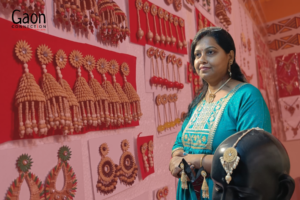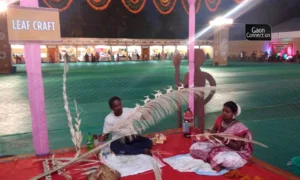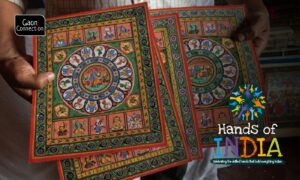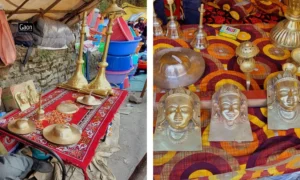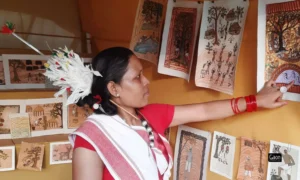It is difficult to miss the pride in the voice of Suraj Narayan Titanwala as he talks of Bagru dyeing and printing. The national award winning Bagru craftsperson was twelve or thirteen years old when he actively began helping out his father in the printing and dyeing process. Now at 61 years of age, he is steeped in his dyeing and printing legacy. Apart from setting up a Bagru Museum, Suraj is finalising a book on the art of Bagru printing too.
Suraj Narayan was born on August 2, 1960 at Bagru Walo ka Raasta in Chandpole, Jaipur, Rajasthan where he watched his father dye and print intricate motifs on swathes of fabric.
Bagru printing is a traditional printing technique done using natural colours. This craft is practised by the ‘chippa’ community in a remote town of Rajasthan. Bagru printing is generally done on a blue or indigo background.
“This is what we have done in our family for generations, from the time of the Raja Maharajas. Main khaandani chippa hoon [I am from the chippa community]. Titanbabu was an ancestor and it was to honour him that I suffixed ‘Titanwala’ to my name,” he said.
Also Read: Bagh block printing is in yards of trouble
“Because it was heavy work, soaking the fabric, squeezing it dry, preparing the colours in huge big vats, pouring it on… I initially helped out with the chores that are a part of our printing and dyeing tradition. It was when I was about sixteen- years-of age that I actively began to work on Bagru prints of my own,” Suraj Narayan recalled.
Some of Suraj Narayan’s fondest memories are of his father taking him along to the hathwada, a weekly Saturday market where people from nearby villages came to buy things, including lengths of the Bagru fabric that his father had dyed and printed.
It was at the weekly outing with his father to the hathwada that Suraj Titanwala met Hiroko Iwatate, a Japanese lady in 1981. “She would buy the printed cloth from us and take them back with her to Japan. She became a good friend of my father’s and later, mine,” he said.
Early journey
The Bagru craftsperson gave up his M.Com after two years, and got a bank job. But Suraj Narayan decided to give that up too. “I wanted to keep this family legacy alive. My two older brothers were not doing it, so I joined my father, Govind Narayan,” he told Slow Bazaar. Suraj Narayan is delighted that his son Deepak Kumar has also decided to be a part of the Bagru craft tradition.
It was in 1990 that Suraj Narayan moved to Bagru from Jaipur, when it became difficult to continue dyeing and printing in Jaipur because of water shortage. He bought land in Bagru and expanded his printing work there.
“I slowly began to increase the work I did there and now I have all the processes of printing and dyeing in the same place,” he said.
Natural colours in Bagru printing
Bagru is one of the unique printing and dyeing traditions in India and it traditionally uses natural colours obtained from Nature. “Indigo, pomegranate peel, turmeric, alum, iron… We used to use the root of the Aal tree that we would boil and wash and dye the material with it. We use only vegetable dyes,” Suraj Narayan said.
Only if a customer asks for a specific colour that cannot be derived from natural dyes, I ask them if they are okay with using chemical dyes. If they are, I use those dyes only for them, he added.
“The Bagru motifs at one time were distinctive. Each community wore a different print and we could tell them apart by just seeing what print they wore,” the Bagru artisan said. The Chippas, including my ancestors, made fabrics for royalty, he added with pride.
Also Read: World-famous Bagh block-printing artisans of Madhya Pradesh are out of work
Bagru Museum
In 1990, Hiroko invited Suraj Narayan to Japan where he visited Osaka, Tokyo and Gifu and gave demos of the Bagru printing and dyeing techniques. He also visited the textile museum Hiroko had set up in Tokyo.
That was perhaps the beginning of an idea in Suraj Narayan’s mind, of setting up a Bagru Museum. It was in 2014 that he actually began to plan, he said. He had his share of the limelight when he had the opportunity of explaining the intricacies of Bagru printing and dyeing to Bill Clinton in 1998 and Prince Charles in 2003. In 2011 he won the President’s Award.
Finally, in 2019, on February 26, the Titanwala Museum was inaugurated in Bagru by Smriti Irani who was then the textile minister.
The museum has all the wherewithal needed for the Bagru craft. The little trays where colours are kept handy, cauldrons where the colours boil bubble and reach the perfect consistency, the different motifs on fabric that made Bagru so unique and of course, the wooden blocks with the patterns painstakingly carved into them.
Also Read: To beat the lockdown blues, traditional artisans of Kachchh in Gujarat go online
“I have only one block maker left who makes the wooden blocks with the traditional motifs,” rued Suraj Narayan. But he said he has a room full of them. “But if I should find someone who continues to make them, I will have so many more made,” he said.
Rising demand for Bagru print
Using these blocks are a time-consuming and long process, so intricate are they. Probably only 10 metres of cloth can be printed a day using the traditional ones, he said. It was not difficult in the olden days and ten metres a day was enough for one and all. The demand was less, people were less, so it was not a problem, but now everything is wanted in larger quantities, Suraj Narayan said.
Now he employs many dyers and printers and they need a livelihood. Printing ten metres a day is not going to cut it. These days it makes more sense to print about 100 metres a day, Suraj Narayan said.
“It is hard work. We work in proximity to cauldrons of boiling colours in the unforgiving summers of Rajasthan. But we get a lot more work done in summers when the days are long and drying the fabric is quick work. In winters, the work is harder as we have to wash miles of cloth in freezing water. The days are shorter too and so less work gets done,” the craftsman said. The prints are brighter and better defined in the summers, he said.
“Summers or winters, this is my life and my livelihood and I would have it no other way,” Suraj Narayan concluded. But not before issuing an invitation: “Visit me, eat the rotifrom my chulha. I will introduce you to the intricacies of this beautiful craft.”
This article first appeared on Slow Bazaar. Read it here.








